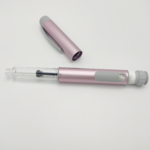When using an insulin injection pen, please pay attention to these three things!
Compared with traditional syringes, insulin injection pens have many advantages, such as:
The insulin and injection device are combined into one, the injection steps are greatly simplified, and the injection is more convenient and concealed;
The injected dose is displayed in digital form through the dose window, which is more accurate than reading with the naked eye;
Allows the use of thinner, shorter needles, making injections less painful.
However, when using an insulin injection pen, you still need to pay attention to the following three issues.
1. Liquid leakage
Many people with diabetes will encounter this situation when using an insulin injection pen: after pulling out the needle, a drop of medicine hangs on the needle, or the medicine overflows from the skin, which is called leakage.
If the leakage is severe, the dose of insulin injected under the skin may be reduced, which may affect blood sugar control.
Leakage can generally be divided into three situations:
1. Liquid leakage at the connection
Leakage from the connection between the pen refill and the needle. This is due to a poor seal between the needle and the insulin refill, causing the medicine to leak out of the injection pen.
Countermeasures:
Ensure needle compatibility with insulin pens has ISO certification.
Check whether the operation is correct. Every time you install the needle, make sure the needle is aligned with the center of the cartridge isolation plug and inserted vertically.
2. Leakage from needle tip
Leakage rarely occurs when injecting with a syringe, but it can easily happen when using an injection pen.
This is because the needle of the insulin pen is very thin, and the time it takes for the liquid to be injected into the body is relatively prolonged during the injection. Moreover, as the amount of liquid injected into the subcutaneous area increases, the absorption rate of the liquid at the location of the needle tip will slow down. If the injection speed is too fast or If you withdraw the needle too quickly, the medicine will easily overflow from the needle tip.
Countermeasures:
Try to choose a needle with a wider inner diameter, that is, a needle with a thinner wall, which can increase the insulin flow rate and reduce leakage.
Remember to keep the needle in place for at least 10 seconds, which is the time between fully pressing the injection button and pulling the needle out of the skin, to ensure pressure is transmitted through all pen components to the insulin refill.
If the dose is larger, the needle retention time needs to be extended, or the injection needs to be divided into two injections to reduce the dose of a single injection.
3. Skin leakage
Skin leakage refers to the overflow of medicinal solution from the needle hole on the skin after the needle is pulled out. This is the most frequent type of leakage reported by patients and observed by medical staff. According to surveys, about 30% of patients have observed skin leakage.
Generally, when the injection dose is larger, higher pressure will be generated and leakage will be more, but small skin leakage (small droplets at the injection site) can be ignored.
In addition, the needle hole is large and the injection is too fast, which can easily cause leakage.
Countermeasures:
Choose a needle with thin-wall or ultra-thin-wall technology. This needle not only has a larger inner lumen and a higher insulin flow rate, but is also thinner, reducing the diameter of the needle hole.
The needle should be retained sufficiently to allow sufficient time for the drug injected into the subcutaneous tissue to disperse into and diffuse within the tissue.
2. Pain
A survey of people with diabetes shows that about half of them are reluctant to start insulin treatment because they are afraid of the pain of injections.
In fact, the needles used in insulin pens are very small. Most insulin injections are painless, and sharp pain is rare. Many patients feel like being bitten by a mosquito.
In addition, everyone should learn some techniques that can help reduce injection pain.
Countermeasures:
Store the insulin you are using at room temperature. Insulin at a lower temperature can induce pain and discomfort.
Choose a shorter length and smaller diameter needle. It is recommended for patients with diabetes to use a 4mm six-section needle.
If alcohol is used to disinfect the injection site, wait until the alcohol has completely evaporated before injecting.
Avoid injecting at the base of body hair.
Use a new needle for each injection to avoid reuse of the needle.
The needle should be inserted smoothly into the skin, not with a sharp thrust. After the injection is completed, quickly pull out the needle in the direction of needle insertion.
3. Save
If the insulin injection pen is stored improperly, it will not only cause damage to the injection pen itself, but may also affect the accuracy of the injection dose and cause safety hazards such as contamination of the medicinal solution.
Countermeasures:
Insulin pens should be stored at room temperature and kept in the packaging box when not in use. Avoid direct sunlight, prevent water, dust and moisture from entering, keep away from heat sources, and keep away from freezing.
Insulin pens in use and their refills should not be stored in the refrigerator. Alternating hot and cold periods may reduce the overall usability and sensitivity of the insulin pen and cause mechanical failure. In addition, it may also cause insulin to leak or air to enter the medicine. in the liquid, which not only affects the injection dose but also causes cross-contamination, causing safety hazards.

